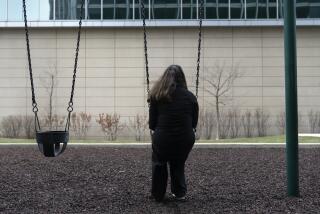Cancer’s lost generation
- Share via
For children and adults, survival rates for many types of cancers have risen steadily over the last two decades. But missing in this success story are adolescents and young adults: They don’t fare as well on average.
Oncologists around the country are trying to draw attention to this discrepancy, setting up clinics for adolescent and young adult cancer patients.
“We have these horrible diseases killing young adults. Why aren’t we doing better?” says Dr. Leonard Sender, medical director of the Cancer Institute at Children’s Hospital of Orange County. “We should be encouraging them to be in clinical trials. We should be getting more money from the National Cancer Institute for research on this age group.”
The hospital’s Cancer Institute recently joined the ranks of cancer centers focusing on this agegroup, launching a program to steer patients 15 to 30 into treatments that could improve their chances of beating the disease.
Increasing the amount of research is at the core of plans to improve survival rates for teens and young adults. Because cancer is relatively rare in those younger than 30, Sender said, grouping young cancer patients at specialized hospitals and clinics could help doctors better understand how to treat them. Not only could they undergo the most promising clinical trials, but the results could be collected and analyzed specifically for their age group.
Doctors also now think that many adolescents and young adults may have better outcomes with pediatric treatment guidelines rather than with adult guidelines. Pediatric cancer centers have long enrolled children into clinical trials that test standard treatments with experimental treatments. Experts credit this aggressive practice with increasing the survival rate of cancer patients younger than 14.
Information recently gathered by Dr. Archie Bleyer, an adolescent and young adult cancer expert at M.D. Anderson Cancer Center in Houston, showed that teens and young adults are not usually enrolled in clinical trials and could be missing out on the best therapies.
“We didn’t realize how far we’d fallen behind,” says Bleyer. “We’d worked so hard to help the younger children, going back to the ‘50s. And in the last 20 years we’ve been focusing on the adults. The fact that we didn’t pay attention to the age group in between has led to some pretty dismal outcomes.”
But the fact that adolescents and young adults generally don’t live as long as other cancer patients is due to more than a lack of awareness by doctors and researchers, Bleyer says. Young adults are the least likely of any age group to have insurance or the financial resources to obtain optimal care. They often can’t travel easily to cancer centers specializing in their age group, and they are the least likely to comply with their treatments.
Another major factor is the lack of clinical trials specifically for patients in this age group. Some medical centers even exclude entrance into pediatric trials to patients older than 21. Teens and young adults often receive adult therapies, but those treatments don’t seem to work as well.
“The adult treatments are not bad, but they are not specific,” says Sender. “The pediatric protocols we have are much more aggressive,” often involving more rigorous treatment with cutting-edge therapies.
For example, one recent study showed that teens and young adults with acute lymphoblastic leukemia who were in an adult-based treatment plan had a five-year survival rate of 41%; similar patients in pediatric clinical trials had a 67% five-year survival rate.
Adolescent and young adult patients who are diagnosed with cancer should be referred to a specialized cancer center for that age group, Sender says. Some centers are abandoning the 21-or-older limit on enrollment in pediatric trials.
“There are many good oncologists in Southern California, but they may see only a few cases of these rare diseases in young adults,” he says. “Unless they are up-to-date or in a treatment network, they don’t have access to the best care.”
One recent study found that children treated for Hodgkin’s disease are 75 times more likely to develop breast cancer as adults. Doctors who specialize in adolescents and young adults -- usually oncologists with expertise in both pediatric and adult cancer -- already had recognized this problem, Sender says.
“We have been very aware of this issue for a long time,” he says. “We have reduced radiation. We use a different chemotherapy that doesn’t give us that type of secondary [cancer]. We follow these patients long-term.”
Adolescent and young adult cancer centers don’t have all the answers, Sender cautions, but at least they know which questions to ask. Among them: What causes cancers unique to this age group, and what doses of chemotherapy are best? (Some doctors suspect that teens and young adults may be under-dosed.)
In addition to providing the most cutting-edge treatments, these centers can provide adolescents and young adults with psychosocial services that are critical to their quality of life and will help them comply with their therapy.
*
(BEGIN TEXT OF INFOBOX)
Age groups and types of cancer
Cancer in adolescents and young adults is different from cancer in other age groups.
Most cancers that occur in children are so-called embryonal cancers, such as neuroblastoma, Wilms’ tumor and retinoblastoma, which are uncommon in those older than 15. And adult cancers, such as lung, breast and colon, rarely occur in teens and young adults.
Teenagers and young adults experience higher rates of Hodgkin’s disease, bone cancers and certain germ cell tumors (a cell involved in sexual reproduction), such as testicular cancer.
Survival rates for a few types of cancers in teens and young adults have increased over the last three decades, including Hodgkin’s disease, thyroid cancer and melanoma.
However survival rates remain less than 60% for others, including Ewing’s sarcoma and acute lymphoblastic leukemia.
Source: National Cancer Institute SEER Pediatric Monograph






